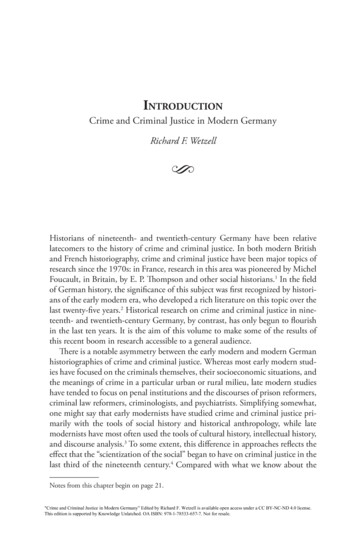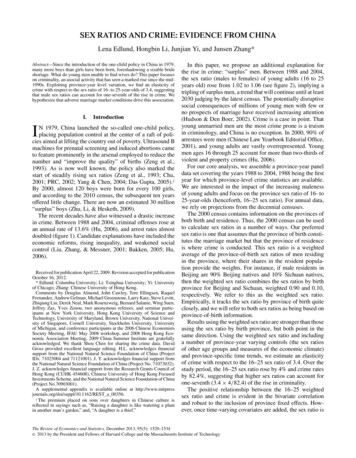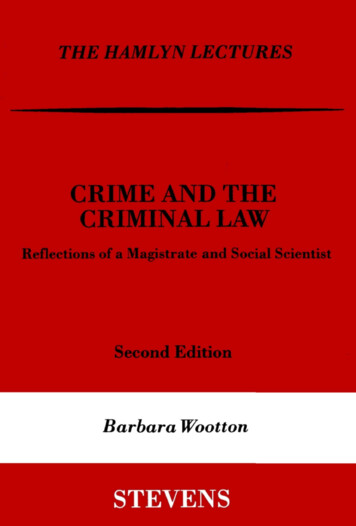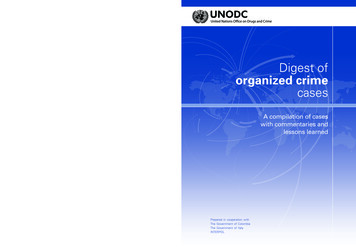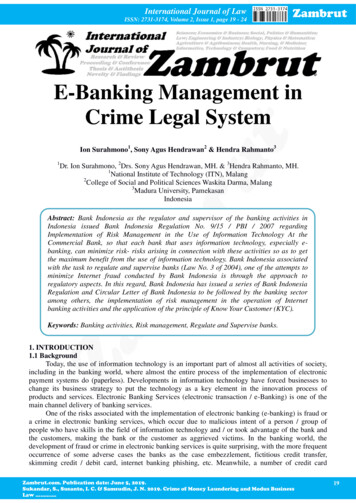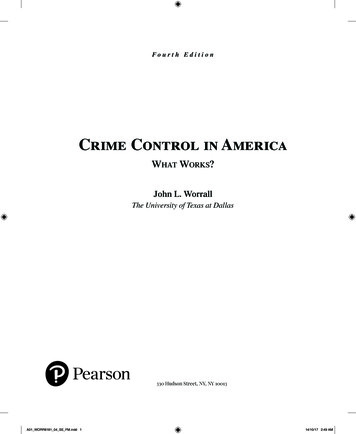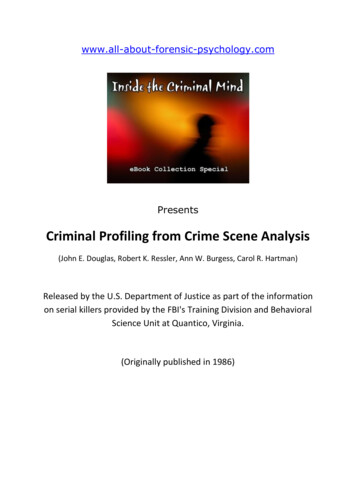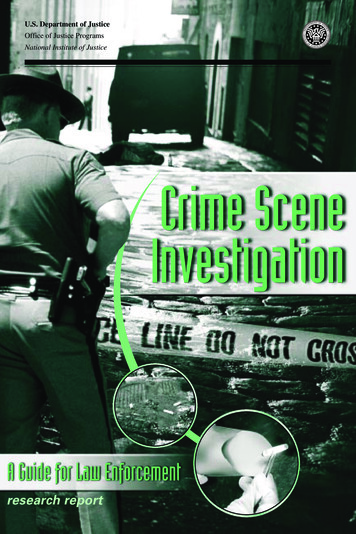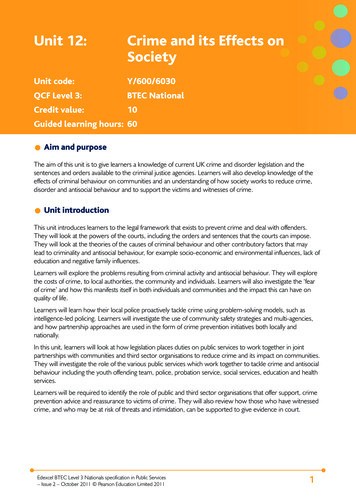
Transcription
Unit 12:Crime and its Effects onSocietyUnit code:Y/600/6030QCF Level 3:BTEC NationalCredit value:10Guided learning hours: 60Aim and purposeThe aim of this unit is to give learners a knowledge of current UK crime and disorder legislation and thesentences and orders available to the criminal justice agencies. Learners will also develop knowledge of theeffects of criminal behaviour on communities and an understanding of how society works to reduce crime,disorder and antisocial behaviour and to support the victims and witnesses of crime.Unit introductionThis unit introduces learners to the legal framework that exists to prevent crime and deal with offenders.They will look at the powers of the courts, including the orders and sentences that the courts can impose.They will look at the theories of the causes of criminal behaviour and other contributory factors that maylead to criminality and antisocial behaviour, for example socio-economic and environmental influences, lack ofeducation and negative family influences.Learners will explore the problems resulting from criminal activity and antisocial behaviour. They will explorethe costs of crime, to local authorities, the community and individuals. Learners will also investigate the ‘fearof crime’ and how this manifests itself in both individuals and communities and the impact this can have onquality of life.Learners will learn how their local police proactively tackle crime using problem-solving models, such asintelligence-led policing. Learners will investigate the use of community safety strategies and multi-agencies,and how partnership approaches are used in the form of crime prevention initiatives both locally andnationally.In this unit, learners will look at how legislation places duties on public services to work together in jointpartnerships with communities and third sector organisations to reduce crime and its impact on communities.They will investigate the role of the various public services which work together to tackle crime and antisocialbehaviour including the youth offending team, police, probation service, social services, education and healthservices.Learners will be required to identify the role of public and third sector organisations that offer support, crimeprevention advice and reassurance to victims of crime. They will also review how those who have witnessedcrime, and who may be at risk of threats and intimidation, can be supported to give evidence in court.Edexcel BTEC Level 3 Nationals specification in Public Services– Issue 2 – October 2011 Pearson Education Limited 20111
Learning outcomesOn completion of this unit a learner should:1Know crime and disorder legislation, sentences and orders2Know the effects of criminal behaviour on communities3Understand approaches to reduce crime, disorder and antisocial behaviour4Understand how the public services support victims and witnesses of crime.2Edexcel BTEC Level 3 Nationals specification in Public Services– Issue 2 – October 2011 Pearson Education Limited 2011
Unit content1 Know crime and disorder legislation, sentences and ordersCrime and disorder legislation: current criminal justice legislation covering crime and sentencing eg Antisocial Behaviour Act 2003, Crime and Disorder Act 1998, Police Reform Act 2002, Criminal Justice Act2003Sentences and orders: general; youth; pre-court measures; antisocial behaviour measures; sentences(financial penalties, community sentences, custodial sentences); restorative justice; orders includingcompensation orders, child safety orders, parenting orders, reparation orders, supervision orders,antisocial behaviour orders, restriction of liberty orders, Community Rehabilitation OrdersImpact of legislation: impact on individuals including offenders, victims and witnesses; impact oncommunities; impact on public services2 Know the effects of criminal behaviour on communitiesCriminal behaviour: theories including biological, sociological and psychological explanations for criminalbehaviour; causal factors eg negative family influences, lack of education, poverty, unemployment, impactof political and socio-economical climateEffects of crime: impact of antisocial behaviour eg damage, graffiti, violence against the person; publicperception of crime (own experience, media influence); fear of crime; impact of crime on victims;impact of crime on lifestyle; ‘real’ and perceived crime figures; collective costs of crime to the communityincluding the cost of supporting victims and witnesses, medical support, the cost of providing criminaljustice services, the need to repair and renovate damage3 Understand approaches to reduce crime, disorder and antisocial behaviourIntelligence-led policing: identification of crime trends; targeting of prolific and priority offenders; creatingproblem-solving policing initiativesSafer communities and multi-agency partnerships: strategies and initiatives (to reduce fear of crime, improvecommunity safety, crime prevention, crime reduction) eg neighbourhood policing, NeighbourhoodWatch, safer community initiatives, crime reduction and prevention initiatives; community action teamsand groups, police community support officers (PCSO), community wardens, Crime and DisorderReduction Partnerships (CDRPs) and Community Safety Partnership (CSPs); third sector organisations egNACROCriminal justice agencies: police, prisons, courts, Crown Prosecution Service (CPS), probation service,youth offending teams (police, probation, social services, education and health services)Edexcel BTEC Level 3 Nationals specification in Public Services– Issue 2 – October 2011 Pearson Education Limited 20113
4 Understand how the public services support victims and witnesses of crimeVictims of crime: businesses; communities; minority groups; vulnerable members of the community;individualsRole of public services: public services eg police, social services, probation service, local authorities,education services, third sector organisations; agencies bound by code of support service for victims ofcrimes; multi-agency cooperation and partnerships; support including advice, practical support, reducingthe fear of crimeVictim and witness support: code of practice for victims of crime; Witness Charter and support servicesincluding court information; victim and witness protection schemes; tackling repeat victimisation; thirdsector organisations including Victim Support4Edexcel BTEC Level 3 Nationals specification in Public Services– Issue 2 – October 2011 Pearson Education Limited 2011
Assessment and grading criteriaIn order to pass this unit, the evidence that the learner presents for assessment needs to demonstrate thatthey can meet all the learning outcomes for the unit. The assessment criteria for a pass grade describe thelevel of achievement required to pass this unit.Assessment and grading criteriaTo achieve a pass grade theevidence must show that thelearner is able to:To achieve a merit grade theevidence must show that, inaddition to the pass criteria,the learner is able to:To achieve a distinction gradethe evidence must show that,in addition to the pass andmerit criteria, the learner isable to:P1outline current crime anddisorder legislationM1 analyse the impact of twopieces of crime and disorderlegislationD1evaluate the impact of onepiece of crime and disorderlegislationP2state the main sentences andorders criminal courts canimposeP3describe two theories ofcriminal behaviour and thefactors that contribute tothemP4describe the effects crimehas on communities and theindividualM2 analyse the effects ofcrime on communities andindividualsD2P5identify approaches used bypublic services to reducecrime, disorder and antisocialbehaviour [IE1]M3 analyse how the strategiesused by the local communitypublic services work toreduce crime, disorder andantisocial behaviour.evaluate a local public serviceinitiative designed to addresscrime and its impact on thecommunity.P6explain how public and thirdsector organisations supportwitnesses and victims ofcrime.PLTS: This summary references where applicable, in the square brackets, the elements of the personal,learning and thinking skills applicable in the pass criteria. It identifies opportunities for learners to demonstrateeffective application of the referenced elements of the skills.KeyIE – independent enquirersRL – reflective learnersSM – self-managersCT – creative thinkersTW – team workersEP – effective participatorsEdexcel BTEC Level 3 Nationals specification in Public Services– Issue 2 – October 2011 Pearson Education Limited 20115
Essential guidance for tutorsDeliveryThis unit should be delivered to focus on active and experiential learning and the opportunities for learnersto research aspects of the content and contribute to classroom discussion both with their tutor and withappropriate public service personnel.Delivery is enhanced where groups of learners take responsibility for researching specific aspects of unitcontent (as agreed with the tutor) and presenting their findings to other learners in the peer group usingpresentation slide shows, posters, leaflets, exhibitions, quizzes and other activity-based approaches. This helpslearners to develop the personal, learning and thinking skills (PLTS) which are an essential part of their overallprogramme, in particular teamworking, independent enquirer and creative thinking skills.Learners need to know about the legislation relating to crime and disorder, and so should be informed on thecurrent legislation and government measures surrounding it. Learners do not need to know the acts in greatdepth, but they should know the main implications of this legislation, particularly regarding partnership workingto reduce crime and the fear of crime, and the sentences and orders available to the criminal courts. Learnersshould understand the difference between the general measures and those in place for youth offenders, andknow about community policing as a result of these acts.Input from court personnel (such as a magistrate or legal adviser) and from members of local crimereduction partnerships and visits to both magistrates’ courts and Crown court will assist in developing learnerunderstanding. Learners should be encouraged to research actual sentences given in a range of current highprofile cases and compare these with the sentencing options available in the sentencing guidelines for thejudiciary that can be found at www.sentencing-guidelines.gov.uk/.Involvement in a mock trial process should be arranged.To gain an understanding of the effects of criminal behaviour, learners should be aware of the range of criminalbehaviour theories (sociological, biological and psychological). However, at this level they are expected onlyto know of them and not go into great detail. They should look at other potential ‘causal factors’ such aspoverty, lack of education and unemployment and be able to discuss these. Learners need to be aware ofthe effects that criminal behaviour has, not just on the actual victim of the crime but also in its widest sense,looking at the costs to society. Individual case studies (compiled from reports of real experiences of the impactof crime on individuals and communities) should be developed. To show a greater understanding of the effectof crime, learners should be encouraged to conduct a survey comparing findings to National Crime Surveyresults.Learners need to understand the approaches and strategies in place that deal with the reduction of crime,disorder and antisocial behaviour. Learners should know about intelligence-led policing, how multi-agencypartnerships are looking to build safer communities, and the strategy and initiatives in place to achieve this.When looking at supporting victims of crime, learners should understand the wide range of ‘victims’ andlook at vulnerable members of communities. The involvement of personnel from witness and victim supportorganisations will help to put this into context. Details of these organisations can be found atwww.victimsupport.org.uk. NACRO also provides speakers and resources which can be accessed viawww.nacro.org.uk.6Edexcel BTEC Level 3 Nationals specification in Public Services– Issue 2 – October 2011 Pearson Education Limited 2011
Accessing these websites and meeting personnel from the organisations will help learners to developan understanding of how public service organisations support victims of crime, working individually andcooperatively with other organisations. Learners should be aware of the victim’s statutory rights, and howpublic services ensure rights are upheld. They should also understand the importance of witnesses in thecriminal justice system and the importance of ensuring witness protection and safety. Care should be takenwhen delivering this content as any learner who has been a witness to crime or a victim of crime may find thistopic sensitive.Crime and disorder television programmes (both factual and fictitious) will provide a useful source of materialfor classroom discussion. This unit should be practically based, encouraging personal research. Contact withcrime reduction and crime and disorder partnerships is strongly advised. This can be done by arranging visitsto or visiting speakers from a variety of agencies, for example: local crime reduction/prevention officer local authority (town/city centre managers, tackling disadvantage team, crime and disorder team) victim support scheme and witness care.Outline learning planThe outline learning plan has been included in this unit as guidance and can be used in conjunction with theprogramme of suggested assignments.The outline learning plan demonstrates one way in planning the delivery and assessment of this unit.Topic and suggested assignments/activities and/assessmentTutor introduces the unit and outlines the assessment.Assignment 1: Crime and its EffectsCriminal behaviour and its impact. The legal framework. (P1, P2, P3, M1, D1).Current crime an
On completion of this unit a learner should: 1 Know crime and disorder legislation, sentences and orders 2 Know the effects of criminal behaviour on communities 3 Understand approaches to reduce crime, disorder and antisocial behaviour 4 Understand how the public services support victims and witnesses of crime. Edexcel BTEC Level 3 Nationals specification in Public Services 3 – Issue 2 .



